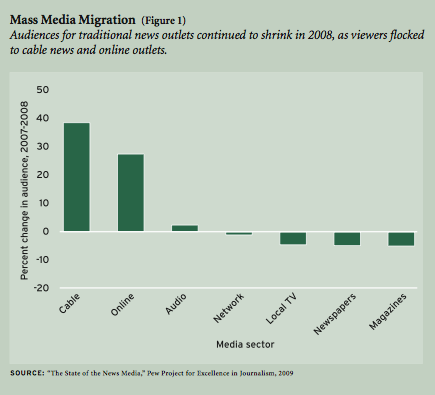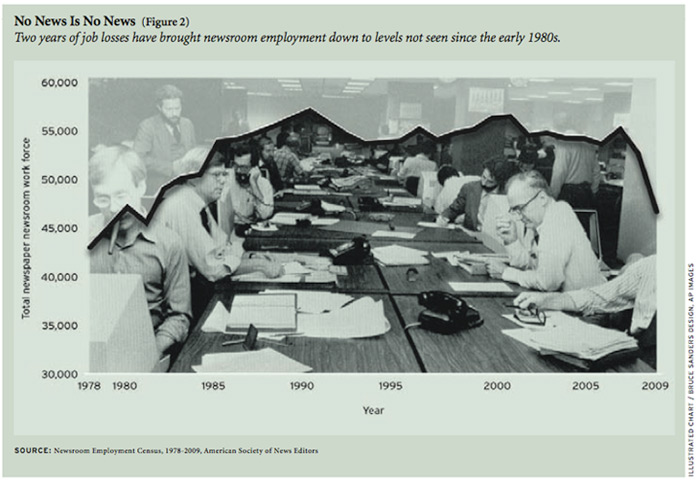 If you haven’t heard the news that the newspaper industry is dying, you must not be reading the newspaper anymore. Which is entirely possible. According to the Pew Research Center, newspaper readership fell 5 percent in just the past year, and advertising revenues are down 23 percent over the past two years. The third quarter of 2008 saw the worst decline in print ad revenue in nearly 40 years, reports the Newspaper Association of America. Several major chains are in bankruptcy, and a few big papers have disappeared entirely. With the economy in deep recession, the situation only looks to grow worse.
If you haven’t heard the news that the newspaper industry is dying, you must not be reading the newspaper anymore. Which is entirely possible. According to the Pew Research Center, newspaper readership fell 5 percent in just the past year, and advertising revenues are down 23 percent over the past two years. The third quarter of 2008 saw the worst decline in print ad revenue in nearly 40 years, reports the Newspaper Association of America. Several major chains are in bankruptcy, and a few big papers have disappeared entirely. With the economy in deep recession, the situation only looks to grow worse.
This is a topic that excites editorialists, who are, of course, members of the journalism profession themselves. Many bemoan the demise of the daily newspaper, arguing that it signals the end to the educated citizen. Others worry that Americans will retreat to ideological safe havens—cable TV channels, Internet sites, and blogs that conform to their strongly held views—which will lead to even greater divisiveness in our politics and culture (see Figure 1).
Are these concerns valid when it comes to coverage of education? To find out, I interviewed some of the smartest minds in education journalism, including Richard Lee Colvin of the Hechinger Institute; Richard Whitmire, president of the National Education Writers Association (EWA); Jim Bencivenga, formerly the education editor of the Christian Science Monitor; Virginia Edwards, the publisher of Education Week; and Elizabeth Green, an editor of the online upstart GothamSchools.
They all agree that the demise of the daily newspaper is bad for the local “conversation” around education. And even if papers survive, already the education beat is being squeezed. Those reporters who remain on the job (see Figure 2) are asked to cover higher education as well as K—12 schools, meaning they have less time to develop expertise in specific areas. They are pushed to write shorter articles, leaving little space for in-depth reporting. And editors want stories that are hyperlocal, at the school level, not missives about the latest school board policies, or dry accounts of state regulatory actions.

As a result, says Whitmire, decisions go unchallenged. “What is lost is that the superintendent will bring in a new program, and nobody will be there to explain to the community whether similar programs have worked or failed in other places.” Colvin goes even further: “We hear from superintendents that the coverage is worse than ever.” All the reporters seem to want is a “couple of quotes” for a “sensationalist” story. So when it’s time for leaders to make the case for, say, budget increases, they have no credible vehicle through which to explain their rationale to the broader public, beyond their own communication outlets, and no independent third party to present opposing views in a fair manner.
“The people who will be excluded from the conversation will be people without kids in the schools,” explains Bencivenga. Those with a vested interest—the teachers unions, realtors—will continue to get their message out. But there will be no one to counter these self-serving opinions. As Edwards argues, “An ill-informed public will benefit people who can push an agenda without accountability and public scrutiny.”
The national scene is unlikely to look so bleak, argue the experts. In part that’s because everyone expects a few of the great national papers to survive. But it’s also because of the well-developed community of think tanks, blogs, and trade publications that follow the education issue, and aren’t disappearing anytime soon. “National will always be the easiest to do,” says Whitmire.
But even at that level, there are signs of trouble. Right now a CEO or university president might skim an education editorial or op-ed while flipping through the Wall Street Journal or New York Times. But imagine if such elites stop getting newspapers and only read articles online that are of immediate interest. The larger public that engages in the K—12 education debate could shrink dramatically, to just partisans engaged in the war of ideas around schooling.
Still, nobody expects high-quality education journalism to disappear without a fight. Already new models are starting to emerge. One of the most talked about is Green’s GothamSchools, an online site that follows New York City’s education scene, and also covers national education happenings. An initiative of the nonprofit Open Planning Project, GothamSchools aims to be a “one stop shop in New York City for education news,” according to Green. It covers education the way newspapers used to, with its two reporter/editors showing up at every meeting of the city council and the state assembly that touches on the public schools. But it also dives in to do more in-depth analyses and investigative pieces.
There are similar experiments up and running in Philadelphia, Cleveland, and Chicago. Plus a growing number of cities, such as Minneapolis and San Diego, are home to new online nonprofit newspapers that feature strong education reporting.
Meanwhile, the national players are tweaking their approach. Hechinger is going into the content-production business, with a growing staff that will write original, long-form articles about key education trends. The EWA has a new “public editor,” former Washington Post reporter Linda Perlstein, who helps cub education writers around the country hone their craft and offers high-level feedback to more-seasoned pros. And Education Week is contemplating how it might distribute its content to daily newspapers.
All of these “business models” have promise, but also big question marks. First, they depend on philanthropic support for start-up revenue; with the stock market, and thus endowments, down some 30 percent, it’s not known whether there will be enough grant dollars to go around. Even Education Week, which has attracted foundation support for years, only receives 25 percent of its revenues from such sources and must bring in the rest from subscriptions, advertising, and elsewhere. Second, it’s unclear whether any of these approaches are sustainable once the grant money inevitably runs out.
So should education reformers try hard to help solve these problems? Would the further diminishment of the newspaper be bad for the cause of change? That’s not quite clear, either. On the one hand, newspaper editorial pages have generally been friendly to supporters of greater accountability, transparency, and parental choice. They have been particularly bullish on charter schools (“Opinion Leaders or Laggards?” what next, Summer 2008). And to be sure, the organized interests of the status quo—particularly the powerful teachers unions—will always find a way to get their message out to core audiences. They would only profit from a world without the fourth estate playing referee.
On the other hand, reporters have never been particularly astute at covering “change,” particularly the variety that causes pain for adults. In this way, the media have not been very friendly to reformers. Colvin puts it best: “Journalists never get out front of reform. They are always the trailing entity. Anyone whose ox is gored by reform is going to be outspoken and resist it. Journalists must understand that there’s always pain and disruption in great change. But they rarely frame it that way.”
Now that it’s the journalists who face pain and disruption, the question is whether they will get out in front of the changes happening in their own industry. No doubt you can follow this developing story in a local newspaper—if you still subscribe to one.


